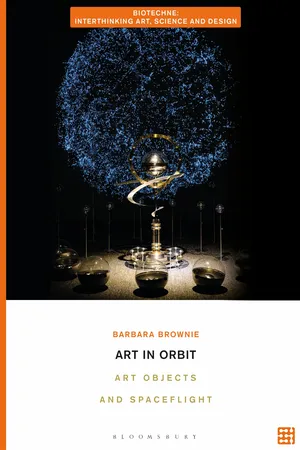
- English
- ePUB (mobile friendly)
- Available on iOS & Android
eBook - ePub
About this book
What role do the visual arts play in the emerging commercial spaceflight industry, and vice versa? This book considers the relationship between art practice and space science, presenting new methodologies for art-sci collaboration informed by non-terrestrial contexts.
Regarded widely as an irreverent luxury accessible to only a select few, commercial space exploration seems an unlikely setting for contemporary art practice. However, faced with the inevitability of this developing industry and the new environments it presents, a new field of creative practice is emerging. In Art in Orbit design theorist Barbara Brownie argues that these new environments offer novel opportunities that are yet to be fully recognized by the creative industries.
Throughout the book, Brownie explores the contexts, questions, challenges and opportunities for creative exploration of form, materials, and the body, in space. Drawing on original research in the STEAM subjects, the book highlights how artists, engineers, and theorists have begun working in close collaboration to reconsider practices that have been taken for granted throughout the history of art practice, demonstrating how ideas about orientation, weight, balance, and the familiar behaviours of art and craft materials are all radically altered in the microgravity of orbital space.
The research presented is supplemented by 9 original case studies from sculpture, craft, performance, and land art, together with exclusive interviews with artists who have produced work for space. Taking an original, critical approach to the spaceflight sector, Art in Orbit sets out to define a new field of artistic practice and the real-world impact of art-sci collaboration. It provides a template for developing new narrative strategies for space projects which will engage artists, scientists, and collaborative teams from across disciplines.
Regarded widely as an irreverent luxury accessible to only a select few, commercial space exploration seems an unlikely setting for contemporary art practice. However, faced with the inevitability of this developing industry and the new environments it presents, a new field of creative practice is emerging. In Art in Orbit design theorist Barbara Brownie argues that these new environments offer novel opportunities that are yet to be fully recognized by the creative industries.
Throughout the book, Brownie explores the contexts, questions, challenges and opportunities for creative exploration of form, materials, and the body, in space. Drawing on original research in the STEAM subjects, the book highlights how artists, engineers, and theorists have begun working in close collaboration to reconsider practices that have been taken for granted throughout the history of art practice, demonstrating how ideas about orientation, weight, balance, and the familiar behaviours of art and craft materials are all radically altered in the microgravity of orbital space.
The research presented is supplemented by 9 original case studies from sculpture, craft, performance, and land art, together with exclusive interviews with artists who have produced work for space. Taking an original, critical approach to the spaceflight sector, Art in Orbit sets out to define a new field of artistic practice and the real-world impact of art-sci collaboration. It provides a template for developing new narrative strategies for space projects which will engage artists, scientists, and collaborative teams from across disciplines.
Frequently asked questions
Yes, you can cancel anytime from the Subscription tab in your account settings on the Perlego website. Your subscription will stay active until the end of your current billing period. Learn how to cancel your subscription.
At the moment all of our mobile-responsive ePub books are available to download via the app. Most of our PDFs are also available to download and we're working on making the final remaining ones downloadable now. Learn more here.
Perlego offers two plans: Essential and Complete
- Essential is ideal for learners and professionals who enjoy exploring a wide range of subjects. Access the Essential Library with 800,000+ trusted titles and best-sellers across business, personal growth, and the humanities. Includes unlimited reading time and Standard Read Aloud voice.
- Complete: Perfect for advanced learners and researchers needing full, unrestricted access. Unlock 1.4M+ books across hundreds of subjects, including academic and specialized titles. The Complete Plan also includes advanced features like Premium Read Aloud and Research Assistant.
We are an online textbook subscription service, where you can get access to an entire online library for less than the price of a single book per month. With over 1 million books across 1000+ topics, we’ve got you covered! Learn more here.
Look out for the read-aloud symbol on your next book to see if you can listen to it. The read-aloud tool reads text aloud for you, highlighting the text as it is being read. You can pause it, speed it up and slow it down. Learn more here.
Yes! You can use the Perlego app on both iOS or Android devices to read anytime, anywhere — even offline. Perfect for commutes or when you’re on the go.
Please note we cannot support devices running on iOS 13 and Android 7 or earlier. Learn more about using the app.
Please note we cannot support devices running on iOS 13 and Android 7 or earlier. Learn more about using the app.
Yes, you can access Art in Orbit by Barbara Brownie in PDF and/or ePUB format, as well as other popular books in Art & Art Theory & Criticism. We have over one million books available in our catalogue for you to explore.
Information
Table of contents
- Cover
- Halftitle Page
- Title Page
- Contents
- List of Illustrations
- Abbreviations
- Introduction. Art Objects in Orbit
- 1 Art in the Commercial Space Age
- 2 Science First, Art Later
- 3 Post-gravity Thinking: How Weightlessness Changes Everything
- 4 New Horizons
- 5 Touching the Void
- 6 Making Space for Experiments
- Conclusion. Finding Space for Artists
- Appendix
- Bibliography
- Index
- Imprint